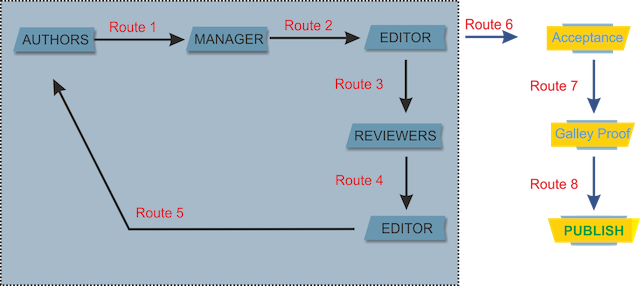| ISSN INTERNATIONAL |
| ISSN INDONESIA |
International Journal of Counseling and Psychotherapy (IJCP) peer review process adheres to ethical guidelines and best practices, which are based on the following policies:
Double-Blind Peer Review Process
International Journal of Counseling and Psychotherapy (IJCP) follows a rigorous peer review process to ensure high-quality publications. Below are the key points of the Peer Review Process:
IJCP Peer Review Process Steps:
All papers undergo full peer review. The IJCP employs a double-blind peer-review process. Detailed information about the manuscript submission flow (from author to acceptance by the editor) is shown in the following figure:

The peer review process described above is detailed below:
The steps point number 1 to 5 are considered as 1 round of the peer-reviewing process (see the grey area in the figure). The editor or editorial board considers the feedback provided by the peer reviewers and arrives at a decision. The following are the most common decisions:
It is important to note that there are no direct correspondences between the authors and editors regarding manuscript rejections. Instead, authors receive information about the review results and the reasons for rejection, if applicable. The final decision on acceptance or rejection is made by the editorial boards, taking into consideration the reviewers' assessments and recommendations. This comprehensive peer review process ensures the quality, validity, and integrity of the published research in the IJCP.
| EDITORIAL POLICIES |
| Editorial Decision Policy |
| Publication Ethics |
| Allegation of Misconduct |
| Peer Review Process |
| Genarative AI (GenAI) Policy |
| Plagiarism Policy |
| Correction and Retraction |
| Widthdrawal of Manuscript |
| Copyright & Licenses |
| Disclaimer Statement |
| Posting Article Policy |
| Open Access Policy |
| Ethics & Informed Consent |
| Revenue Source Policy |
| Advertising Policy |
| Direct Marketing Policy |
| Authorship & Contributorship |
| Publication System & Process |
| Archive Policy |
| Articles Processing Charge |
| AUTHOR GUIDELINES |
| Auhor Guidelines |
| Copyright Notice |
| Privacy Statement |
| Author Statement of Ethics |
| How to Register |
| How to Online Submission |
| JOURNAL TEMPLATE |
| VISITORS STATISTIC |
International Journal of Counseling and Psychotherapy (IJCP) by Academia Edu Cendekia Indonesia (AEDUCIA) is licensed under Creative Commons Attribution-ShareAlike 4.0 International (CC BY-SA 4.0)
You are free to: Share - copy and redistribute the material in any medium or format for any purpose, even commercially. Adapt - remix, transform, and build upon the material for any purpose, even commercially. Under the following terms: Attribution - You must give appropriate credit, provide a link to the license, and indicate if changes were made. You may do so in any reasonable manner, but not in any way that suggests the licensor endorses you or your use. ShareAlike - If you remix, transform, or build upon the material, you must distribute your contributions under the same license as the original. No additional restrictions - You may not apply legal terms or technological measures that legally restrict others from doing anything the license permits.
JOURNAL's EDITORIAL OFFICE:
International Journal of Counseling and Psychotherapy (IJCP)
Mailing Address: Jl. Permana Barat IV No. 3. Kelurahan Citeureup, Kecamatan Cimahi Utara, Kota Cimahi, Bandung, Provinsi Jawa Barat, Kodepos: 40512, Indonesia. Email: ijcp.ojs@aeducia.org, journal.ijcp@gmail.com. Journal homepage: https://ojs.aeducia.org/index.php/ijcp/ - ojs.aeducia.org. Phone (WhatsApp): +62857-9388-6665.
Publisher: Academia Edu Cendekia Indonesia (AEDUCIA)
Mailing Address: Jl. Permana Barat IV No. 3. Kelurahan Citeureup, Kecamatan Cimahi Utara, Kota Cimahi, Bandung, Provinsi Jawa Barat, Kodepos: 40512, Indonesia. Email: admin@aeducia.org, cv.aeducia@gmail.com. Phone (WhatsApp): +62857-9388-6665. Website: https://aeducia.org.
Visit the Journal Publishing Office Location:
